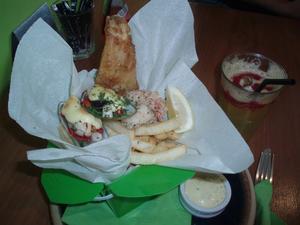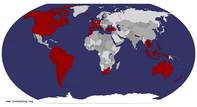Advertisement
Published: December 22nd 2006

 Birthday Lunch
Birthday Lunch
In the intriguingly-named Goolwa on my birthday. A tasy birthday lunch of fresh Fleurieu seafood and chips.Leaving our campsite at Salt Creek, as well as Larry's remains - sucked dry and respectfully placed in the rubbish bin - we continue our drive northwards along the Limestone Coast before turning left towards the Fleurieu Peninsula. This finger of land juts out westwards into the Great Australian Bight, sixty or so kilometres south of Adelaide. "The Fleurieu" is a popular destination for holidaying Australians, and has acquired something of a "foodie" reputation. Sounds like our kind of place...Our destination for the moment, however, is not the peninsula itself but the island that lies at its tip.
Getting to the peninsula from the Coorong involves crossing Australia's largest and most important waterway - the Murray River. At this point there are no bridges spanning the river, a modest one by European standards, so we take a free car-ferry across. The weather seems to be warming up a little and as we drive along the Fleurieu we are treated to a stunning landscape of rolling hills dotted with vineyards - a wonderful blend of natural and man-made features.
First stop on the way is Goolwa, a small and friendly town on the southern coast of the peninsula, liberally sprinkled

 Granite Island Tram
Granite Island Tram
The horse-drawn tram between Victor Harbour and Granite Island, which has been running for many a decade.with cafés and bakeries. Since it just so happens to be my birthday, we make a longer than usual stop at a café for lunch to celebrate my having reached the grand old age of twenty-five.
Kangaroo Island is where we are heading. The island is an undeveloped haven for Australian wildlife, some species native to the island and some introduced there more recently to ensure their survival given the absence of natural predators on the island. We hope to do some good wildlife-spotting on the island during our intended three-day stay there.
First we have to get there. Kangaroo Island is linked to Cape Jervis at the very tip of the Fleurieu by a ferry, which runs several times a day to Penneshaw on the island. For a thirty minute crossing the ferry is rather expensive, but that's the price you pay for getting a campervan across !
The same afternoon we drive from Goolwa to the Fleurieu's largest town, Victor Harbor (and no I haven't turned American - moi ? - it is
Harbor). Here we start with our now well-established routine of a visit to Coles (big Australian supermarket chain) to top up the

 Granite Island
Granite Island
The coast of Granite Island is exposed to the wild winds and seas typical of Australia's south coast.campervan fridge and cupboards with all sorts of goodies (including regular supplies of chocolate, to keep awake on long drives of course), followed by the petrol station. We then park along the sea front and head to Granite Island, a small speck of land a few hundred metres off the coast in Encounter Bay and connected to the mainland by a causeway. The bay in which the island sits is so-called as it was the meeting place, in the early 19th century, between two geographical surveying teams, one British and one French. Despite the two countries being at war with each other at the time, the meeting was apparently perfectly good-natured...
The main attraction of Granite Island, apart from the cutesy horse-drawn tram that runs along the causeway, is its population of Fairy Penguins. This little birds are, as their species name -
Eudyptula minor - suggests, are the world's smallest penguins, and are also known by the name of Little Penguin or Blue Penguin. They are to be found in scattered colonies all around New Zealand, Tasmania, and along the Southern coast of Australia - Granite Island is home to a small population of these birds. Another has

 Reversing to an audience
Reversing to an audience
William backing the campervan onto the Kangaroo Island Ferry. Successfully, I might add.made its home on Philip Island very near Melbourne, but the nightly "penguin parade" there has become an uncontrolled tourist circus show, so we have come here to watch these little birds instead. Nightly tours in small groups depart from the causeway after dusk, when the penguins emerge from the dark, cold seas to return to their burrows, located in and amongst the rocks along the shore. The birds spend several days at a time out to sea, diving continuously to catch fish - it is no surprise that when they return to shore they are exhausted and particularly vulnerable to predators, not least humans in their cars. Signs around the island warn visitors and vehicles that penguins have right of way !
Armed with a torch emitting non-dazzling red light, a guide takes us to several spots on the island where we can see the small silhouettes emerging from the water and hopping, extremely cautiously and slowly, inland towards their burrows and chicks. The birds are adorable and really do live up to their name of Little Penguin ! By the time the walk ends it is dark and extremely cold and we head back to the campsite

 "The Girls" at lunch
"The Girls" at lunch
The Island Pure sheep dairy on Kangaroo Island, which produces a range of delicious organic sheep's cheeses. Feta, halloumi, manchego to name but a few. Well done girls.and a dinner of kangaroo steaks. Exploding kangaroo populations and regular culls mean that kangaroo meat is plentiful and cheap in Australian supermarkets, and very tasty too.
The following morning we make an early start and complete our drive to the very tip of the Fleurieu Peninsula at Cape Jervis, where our ferry to Kangaroo Island departs from. There are two vessels operating along this route, the
Sealion - a regular passenger and car ferry - and the
Spirit of Kangaroo Island - a passenger and freight ferry otherwise known as the "sheep ferry". Indeed, the ferry has no roof to allow tall livestock-carrying trucks onto the vehicle deck. The smell on the deck of the
Spirit is apparently part of the fun...so guess which one we're on ? But no animals on this crossing, as the livestock carriers are returning to the island empty to pick up their next cargo of live sheep.
Getting on to the ferry in the campervan was something of a tense experience. The ferry is not of the roll-on, roll-off kind so all vehicles have to board in reverse, including massive HGVs. It's quite a delicate operation. I am amongst the first

 Salty salt
Salty salt
Just like the Coorong, Kangaroo Island has many dry salt lakes, which fill only briefly during the course of the year.to board (for some reason passengers not driving have to board on foot) so I have the dubious pleasure of reversing the rather clunky campervan, complete with iffy clutch, up a ramp in front of an audience. Not the time to suffer from performance anxiety...With expert guidance from the ferry crew I manage to squeeze the van in with minimal stalling (only a dozen or so times...). I'm just glad we decided not to hire that articulated fuel tanker and opted for the campervan.
The crossing is over in half an hour or so and we roll onto Kangaroo Island, a rural place dominated by sheep farming and a sprawling national park. On our first afternoon we drop into the Island Pure Dairy, an organic dairy which produces cheese and yoghurt from its herd of sheep. Tours of the dairy allow visitors to see the cheese being made (all by hand in a tiny kitchen) and to taste some of the production - feta, halloumi, manchego...We were also able to watch the sheep being milked, which was quite an amusing sight: the "girls", as they were referred to here, queue up in their stalls in a strict order of

 On the sunbed
On the sunbed
Just a few of Kangaroo Island's population of Australian sealions sunning themselves on the beach.seniority (not quite sure if this is based on age, udder size or some such, but the sheep know and that's what matters apparently) and reverse out without prompting as soon as the milking is finished. The whole process is military in its precision and execution. Well done, girls ! The cheese are particularly tasty and are exported all over South Australia - we make off with a nice piece of halloumi for dinner.
Over the next three days we discover at a sedate pace the natural delights of Kangaroo Island, which is home to a huge variety of animal and plant species. In Seal Bay we take a walk onto the beach to watch the resident colony of Australian sealions basking in the sun, rolling around in the sand and squabbling with their neighbours. Further along at the western end of the island, another colony, this time of New Zealand fur seals, can be seen resting on rocky ledges by the ocean and cavorting in the shallow, clear waters. It's the first time I've seen such creatures in the wild - they are beautiful to watch. The coastline of Kangaroo Island is very exposed and the howling southwesterly

 Aaaaaah...
Aaaaaah...
An exhausted sealion takes a nap.winds are back. Our campsite on Kangaroo Island is surrounded by eucalypt forest and is home to an abundance of koalas, noisy parrots and wallabies. We took a walk amongst the trees one morning to watch tiny wallabies hopping about in the undergrowth foraging for food. The koalas here are much less numerous than they used to be, with many having been sterilised or culled in recent years as their exploding population threatened to wipe out the island's gum trees.
The entire western half of the island - which at 120km long is much larger than most people expect when they arrive here - is occupied by the Flinders Chase National Park, an untamed wilderness that is largely inaccessible. There are several walks around small parts of the park which we went on, hoping to spot the elusive platypus which was introduced here decades ago. Sadly, despite much waiting in silence around one of the creatures' regular haunts, we were not rewarded with a sighting of this exceedingly difficult-to-spot creature. Next time, perhaps...What we were able to watch were large numbers of kangaroos and wallabies, as well as an echidna busy tearing apart a falling tree looking for ants

 While another...
While another...
...rests right underneath the boardwalk leading to the beach.with its long spindly tongue. Australian wildlife is remarkably fearless and tame, and as long as you are quiet you can watch the animals very close-up indeed. Having said that, on our way back from the walk in the fading light, we happened upon a wallaby feeding by the path which had not noticed our approach. It practically jumped three feet in the air - as did we - before hopping away into the darkness...
Our drive back to Penneshaw on the last day (to catch the ferry back) was interrupted briefly by a koala that had decided to cross the road and have a bit of a sit down right in the middle. We practically had to get out of the car to shoo it back into the bushes - goodness knows what had possessed it to take a rest there, just beyond a sharp blind bend. Stoned, indeed.
The ferry home was once again the cattle-ship (honk honk)
Spirit, which was this time loaded with several trailers full of rather restless, fractious sheep (not to mention rather perfumed) which jostled and bleated all the way back to Cape Jervis.
Advertisement
Tot: 0.31s; Tpl: 0.013s; cc: 25; qc: 113; dbt: 0.1675s; 1; m:domysql w:travelblog (10.17.0.13); sld: 1;
; mem: 1.3mb
























